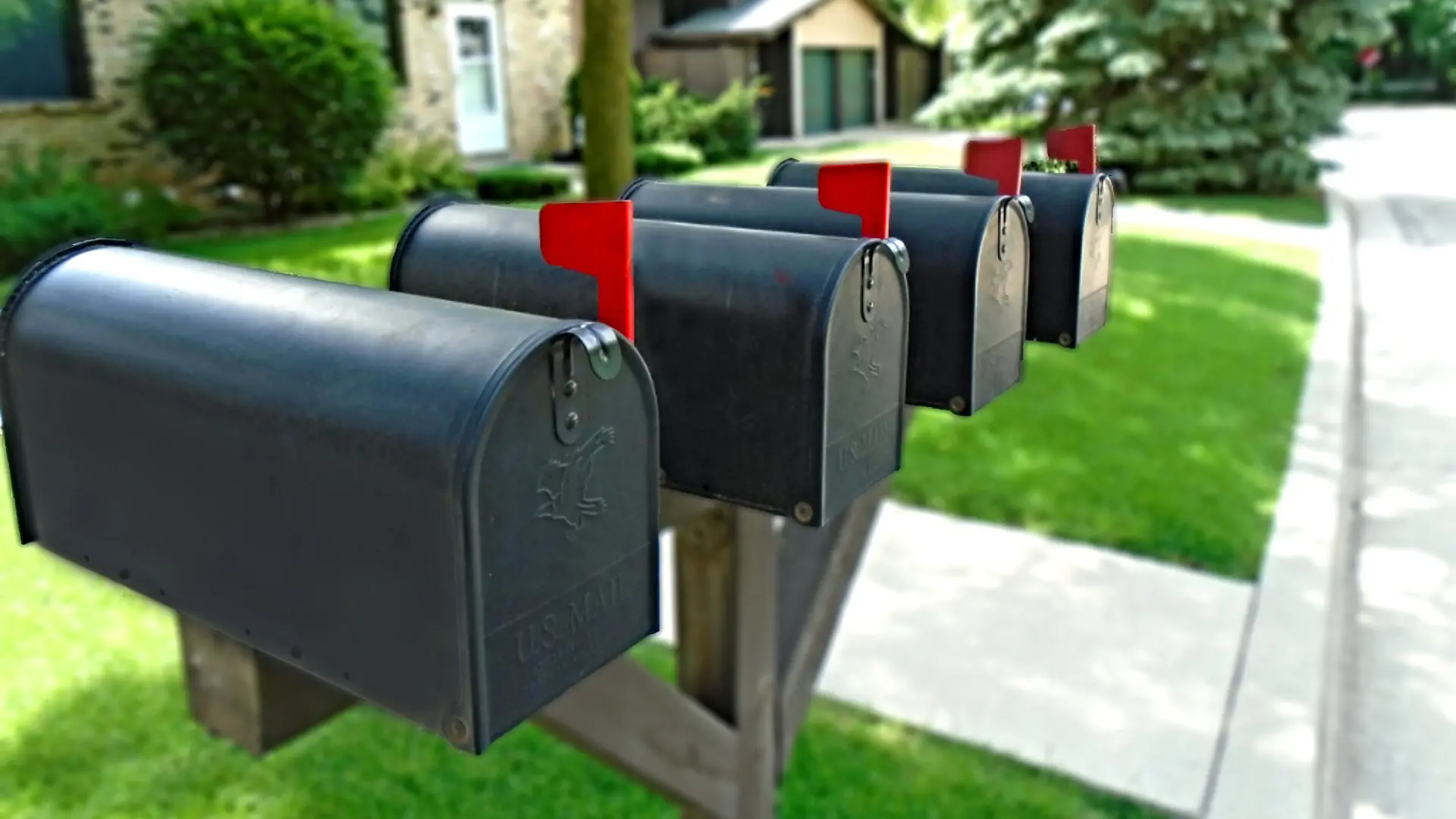Direct Mail Farming
If you’re running a business, you’re probably familiar with the challenges of promoting your products or services. In today’s digital world, there are plenty of online marketing options available, but they can be expensive and highly competitive. That’s where direct mail marketing comes in – and EDDM (Every Door Direct Mail) is a great way to get started.
Here’s the deal: EDDM is a direct mail marketing service offered by the United States Postal Service that lets you reach every household in a specific carrier route. It’s a budget-friendly option that can help you reach a lot of potential customers with your marketing message.
What is Farming?
Real estate farming is choosing to specialize in one demographic or geographic area where you can unlock the potential to become an authority in that specific real estate market and become a sought-after commodity in and of yourself. It’s achieved through consistency, efficiency, expertise and using the right tools. In short, it’s about making yourself the first person think of when they think real estate.
Geographic Farms
By far the most common type of farming by real estate agents. Geographic farms can be identified by specific boundaries, neighborhoods, zip codes, and postal carrier routes – the last of which is what we’re focusing on in this blog.
Economic Farms
Agents focusing on economic farming are typically looking for homesellers in a particular price bracket, often times luxury. Searching and filtering tax records by assessed value is the quickest and easiest way to build such farms.
Demographic Farms
Agents looking to farm to a particular type of seller will certainly use demographic farming. This allows you to target your message to specific people in an area. For example – seniors, long term owners, homes with pools, etc. Mobile apps such as MyFirstAM and REISource are invaluable for building such farms.
Renters
Apartments and rental properties are ground zero for large scale numbers of potential prospects to which to farm. They typically all share on common address with just different unit numbers. If you can get to the mail kiosk, you can snap photos of the unit numbers en masse.
How to Pick a Farm
For the purposes of this blog, we are going to focus on Geographic farming using a program from the Post Office called Every Door Direct Mail (E.D.D.M). The first step to farming is to decide on a farm that is likely to produce for you. We’re going to run through a worksheet that will help you pinpoint good farming areas.
Farm Analysis
The best way to find a a productive farm is by way of a simple calculation. Pick a neighborhood that you have an interest in and look up how many total homes are in that neighborhood. By far the easiest way to do this is to use the county tax database and search by neighborhood, being sure to include all sections. The database should give you a count of unique home addresses.
From there, you’ll want to search the MLS for the total number of Active, Pending, Pending Continuing to Show, and Option Pending listings are in that neighborhood. Also look up the total number of sales in the 365 days. Once you have those numbers, you can perform the following quick calculations:
- Divide the total number of Active, Pending, Pending Continuing to Show, and Option Pending homes by the total number of homes in the neighborhood. That will give you the turnover ratio for Active/Pending Homes. Look for ratios over 6%.
- Second, and more important, divide the total number of sales by the total number of homes in the neighborhood. That will give you the turnover ration for Sales in the neighborhood. Target farms over 8%.

Building Authority
Farming by postcards or letters, even if done consistently will only get you so far. To build real authority in your farm areas, you’ll want to back up your mailing efforts with other methods:
- Work on your website. Google is an incredibly powerful tool to help you stay top of mind in your community. Take advantage of Google My Business to build your online presence.
- Door Hangers. Door hangers are a tried and true method of reaching homeowners. Why are they so effective? Unlike mail, homeowners have to physically remove door hangers.
- Door Knocking. Door knocking is still a great way to get to know your neighbors. What’s more, it’s 100% free. All you need is a pair of sneakers and a desire to meet your neighbors.
- Facebook Advertising. Facebook continually changes their targeting criteria to conform with fair housing laws, but can you narrow your target to 15 miles and include other qualifiers.
- Nextdoor. One of the best ways to develop relationships is simply to participate in online forums such as NextDoor, Facebook Groups, or City Data forums.
- Local Events. One of the best ways to meet potential clients is through local events, meetups or networking groups. Focus on being social first, then on business.
Setting a Budget
Farming is NOT a one-and-done method of building your business. It is better in the long run for you to farm to 100 homes 12 times a year than to farm to 1200 homes once a year or even 600 homes twice a year. For this reason, you need to commit to a budget that will take you through at least one year, even if it means shrinking down your farm
Spend Projections
Farming is almost certainly going to be one weapon in your marketing arsenal, so when you’re budgeting for your farm, create that budget as part of a larger marketing plan. Each year, we plan out a 6 pronged attack including Farming, Sending Expired Letters, Sending FSBO Letters, Sending Personal Notes, Delivering Open House Flyers, and Sending out Just Listed / Just Sold cards. And we budget for ALL of that marketing once a year:

Then, once you’ve got the whole marketing plan set, break down what your farming budget really looks like and look for ways that you can decrease that expense. In our case, we break down what it costs to print our postcards, what it costs to have them shipped to us, and then the EDDM costs associated with mailing them out. We annualize that amount, and plan for sponsors, to whom we’ll include a piece of their marketing on our mailers, and adjust our monthly spend according to what the sponsors are contributing:
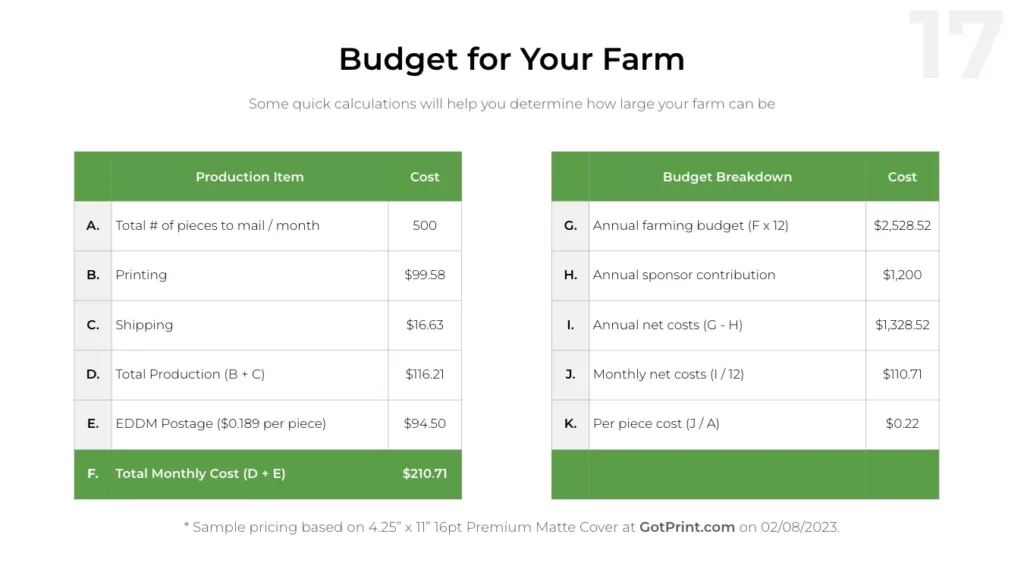
Scheduling Your Mailings
A good schedule to follow for sending out your farming pieces is once per month for a total of 12 touches minimum annually. Some of our agents have had good success making those touches a little more frequently, from every 21 to 25 days. Regardless, unless you’re hiring a firm to manage your mailings, you’ll also need to build in production timelines.
Timeline Planning
Understand that when you’re doing your own mailings, each step of the way will have their own timelines. For example, we use GotPrint.com to create our mailings and it usually takes 4 – 7 days from the time we create our order, for it to get processed and shipped. Shipping can take another 5 – 7 days. And then bundling and delivering them to the post office can take another two days. So if your mailings contain time sensitive content, you’ll need to plan accordingly.
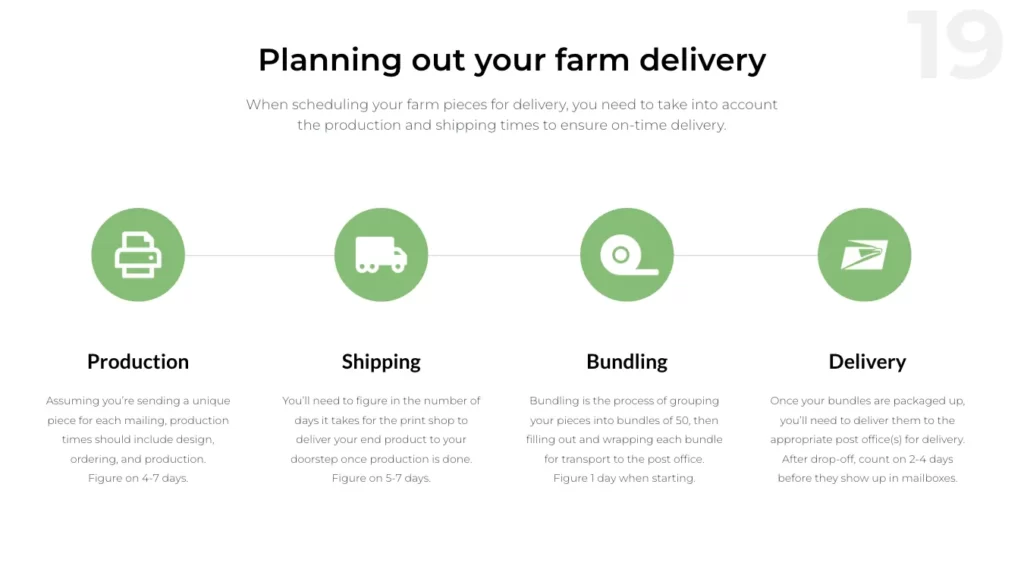
How to Use Every Door Direct Mail
USPS Every Door Direct Mail (E.D.D.M) is an affordable targeted advertising technique that lets you map your marketing mail audience by age, income, or household size and then deliver them easily and affordably by post carrier route. Next, we’ll walk through the steps to assemble an EDDM mailing.
Create a USPS Account
The first step is to create your FREE USPS account. To set up your USPS Every Door Direct Mail Business account, visit https://www.usps.com. And in the top right corner, click Register/Sign In. Follow the prompts to select a username, enter your security information, then choose an account type.
Select Your Routes
Next, once you’re logged in, click on Business on the top menu bar, then select Using EDDM, then finally click the EDDM Online Tool button (or just click here). Next, center your target by entering a starting address that is in your farm. Your home address if farming your own neighborhood.
The drop downs allow you to filter your results by age, income, & home size, then click the search icon. Hover your mouse over the greyed areas. As they light up, you’ll receive summary count of properties and cost. Click to select a route.
Create a Mail Piece
Next, it’s time to create your mail piece. We create ours ourselves using tools like Adobe Illustrator, but you can also use online tools like Command or Canva, just make sure you have the correct dimensions provided by your printer; and make sure you’re selecting a size that is Every Door Direct Mail eligible. See the EDDM User Guide here.
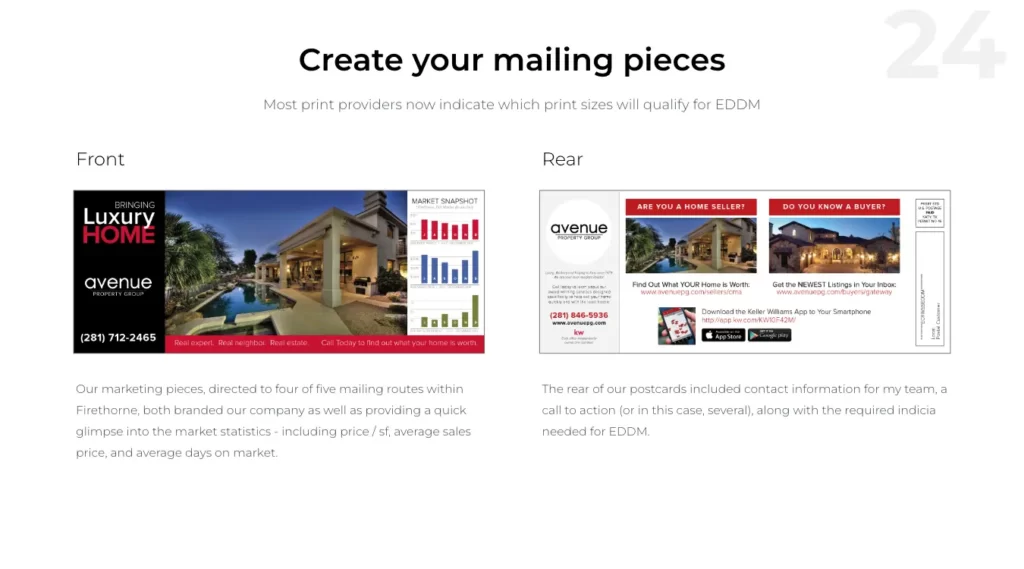
Prepare Bundles
The United State Post Office requires that Every Door Direct Mail mailings be bundled into stacks of either 50 or 100 pieces, and be no higher than 6” tall. Count out your first stack, then use it as a reference to create subsequent bundles.
You can also use a food scale to weigh your reference stack, then create subsequent stacks of equal weight. Finally, each bundle should have a facing slip attached to the top of it.
Complete Forms
Actually, when you create your mailing on the EDDM website, you’ll be provided with a fully completed form that you simply present to the post office along with your mail pieces when you drop them off.
The form will indicate whether you paid online or will be paying in person when dropping off your mailings. I typically fold this form, and attached it to the top bundle in my mailing.
Submit Mailing
Once you’ve got your mailing bundled into stacks of 50 or 100, each with a facing slip and rubber-banded, and your EDDM form – load it into a carry crate and make your way to the indicated post office. Your mailings should start showing up in mailboxes within a few days.
Time vs. Money
The first agents do an EDDM mailing, I usually recommend they plan on the whole process taking an hour or two. Once you’ve got a couple under your belt though, the process of sorting and bundling takes no more than about 15 minutes. I usually then drop the bundles off on the way home. But since there are always companies that will do the work for you, particularly printing companies, agents will want to weight the option of doing the work themselves vs. paying their printing companies to do the heavy lifting.
We ran a comparison with our printing company, 500 postcards sent to one farm. Option 1 was to have the printing company print the cards, ship them to use, and then we bundled and delivered them to to post office for mail out. Option to was to have the printer do the mail outs. The DIY method, Option 1, costs us $210.71 plus our time. The Done-For-Us method, Option 2, costs $298.71. Roughly about $90 more per month to save a little time. Over the course of one year, that’s the better part of $1,100.
Your time vs. your money. You make the choice.
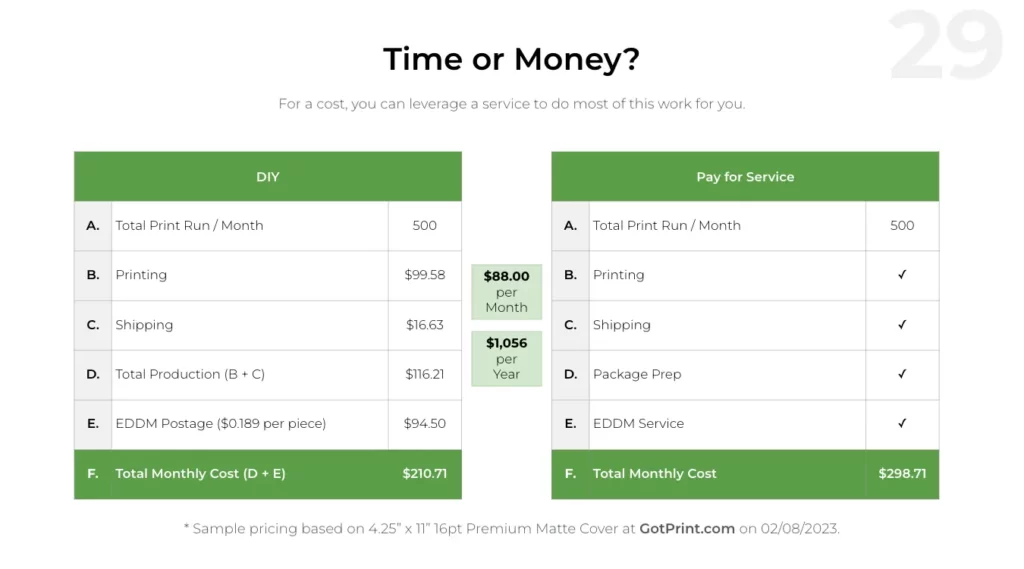
Our Final Thoughts
So, there you have it! EDDM is a powerful marketing tool that can help you reach your target audience, build your brand, and increase sales. By taking advantage of its cost-effectiveness, targeting capabilities, and flexibility, you can get your marketing message in front of the right people and achieve your marketing goals.
Farming is coming back into fashion again because few people do it anymore, opting instead for the much sexier social media. But what if you did both and cross marketed your farming materials as social collateral? Back that up with community involvement and participation, sponsorships, and volunteerism and you’ve got winning formula to but your business top of mind.
Good luck!
